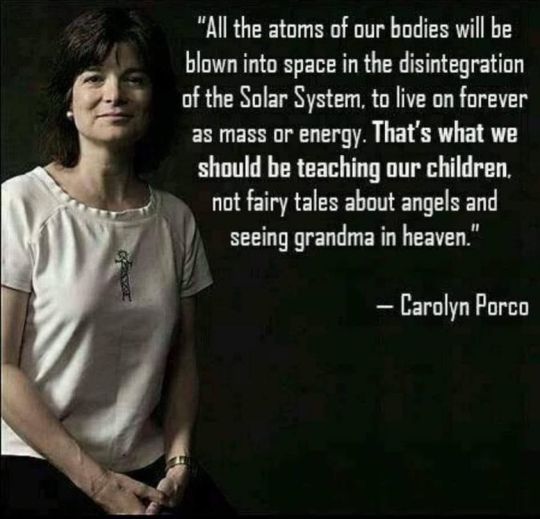Don't wanna be here? Send us removal request.
Text
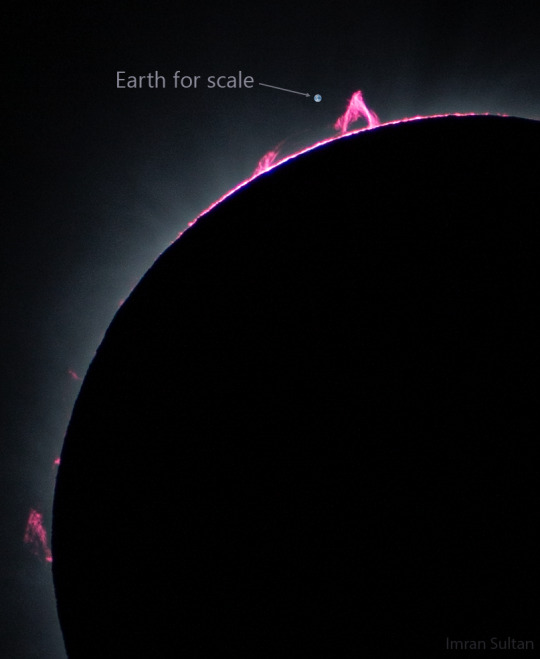
During the total solar eclipse I could see solar prominences with my naked eyes. This shot shows an absolutely enormous one, the tiny dot is Earth added for scale.
963 notes
·
View notes
Link
7 notes
·
View notes
Text
“Never give up on a dream just because of the time it will take to accomplish it. The time will pass anyway.”
— Earl Nightingale (via themedicalstate)
504 notes
·
View notes
Photo








US Surgeons Transplant Pig Heart into Human Patient
U.S. doctors have transplanted a pig heart into a patient in a last-ditch effort to save his life — a first for medical science.
In a medical first, doctors transplanted a pig heart into a patient in a last-ditch effort to save his life and a Maryland hospital said Monday that he’s doing well three days after the highly experimental surgery.
While it’s too soon to know if the operation really will work, it marks a step in the decades-long quest to one day use animal organs for life-saving transplants. Doctors at the University of Maryland Medical Center say the transplant showed that a heart from a genetically modified animal can function in the human body without immediate rejection.
The patient, David Bennett, a 57-year-old Maryland handyman, knew there was no guarantee the experiment would work but he was dying, ineligible for a human heart transplant and had no other option, his son said.
“It was either die or do this transplant. I want to live. I know it’s a shot in the dark, but it’s my last choice,” Bennett said a day before the surgery, according to a statement provided by the University of Maryland School of Medicine.
On Monday, Bennett was breathing on his own while still connected to a heart-lung machine to help his new heart. The next few weeks will be critical as Bennett recovers from the surgery and doctors carefully monitor how his heart is faring.
There’s a huge shortage of human organs donated for transplant, driving scientists to try to figure out how to use animal organs instead. Last year, there were just over 3,800 heart transplants in the U.S., a record number, according to the United Network for Organ Sharing, which oversees the nation’s transplant system.
“If this works, there will be an endless supply of these organs for patients who are suffering,” said Dr. Muhammad Mohiuddin, scientific director of the Maryland university’s animal-to-human transplant program.
But prior attempts at such transplants — or xenotransplantation — have failed, largely because patients’ bodies rapidly rejected the animal organ. Notably, in 1984, Baby Fae, a dying infant, lived 21 days with a baboon heart.
The difference this time: The Maryland surgeons used a heart from a pig that had undergone gene-editing to remove a sugar in its cells that’s responsible for that hyper-fast organ rejection. Several biotech companies are developing pig organs for human transplant; the one used for Friday’s operation came from Revivicor, a subsidiary of United Therapeutics.
“I think you can characterize it as a watershed event,” Dr. David Klassen, UNOS’ chief medical officer, said of the Maryland transplant.
Still, Klassen cautioned that it’s only a first tentative step into exploring whether this time around, xenotransplantation might finally work.
The Food and Drug Administration, which oversees such experiments, allowed the surgery under what’s called a “compassionate use” emergency authorization, available when a patient with a life-threatening condition has no other options.
It will be crucial to share the data gathered from this transplant before extending it to more patients, said Karen Maschke, a research scholar at the Hastings Center, who is helping develop ethics and policy recommendations for the first clinical trials under a grant from the National Institutes of Health.
“Rushing into animal-to-human transplants without this information would not be advisable,” Maschke said.
Over the years, scientists have turned from primates to pigs, tinkering with their genes.
Just last September, researchers in New York performed an experiment suggesting these kinds of pigs might offer promise for animal-to-human transplants. Doctors temporarily attached a pig’s kidney to a deceased human body and watched it begin to work.
The Maryland transplant takes their experiment to the next level, said Dr. Robert Montgomery, who led that work at NYU Langone Health.
“This is a truly remarkable breakthrough,” he said in a statement. “As a heart transplant recipient, myself with a genetic heart disorder, I am thrilled by this news and the hope it gives to my family and other patients who will eventually be saved by this breakthrough.”
The surgery last Friday took seven hours at the Baltimore hospital. Dr. Bartley Griffith, who performed the surgery, said the patient’s condition — heart failure and an irregular heartbeat — made him ineligible for a human heart transplant or a heart pump.
Griffith had transplanted pig hearts into about 50 baboons over five years, before offering the option to Bennett.
“We’re learning a lot every day with this gentleman,” Griffith said. “And so far, we’re happy with our decision to move forward. And he is as well: Big smile on his face today.”
Pig heart valves also have been used successfully for decades in humans, and Bennett’s son said his father had received one about a decade ago.
As for the heart transplant, “He realizes the magnitude of what was done and he really realizes the importance of it,” David Bennett Jr. said. “He could not live, or he could last a day, or he could last a couple of days. I mean, we’re in the unknown at this point.”
By Carla K. Johnson and Lauran Neergaard.
140 notes
·
View notes
Text
Our Galaxy is Caught Up in a Giant Cosmic Cobweb! 🕸️
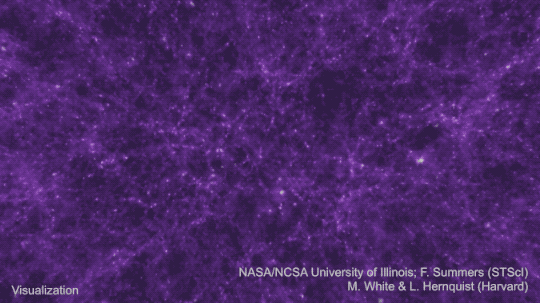
If we could zoom waaaay out, we would see that galaxies and galaxy clusters make up large, fuzzy threads, like the strands of a giant cobweb. But we'll work our way out to that. First let's start at home and look at our planet's different cosmic communities.
Our home star system
Earth is one of eight planets — Mercury, Venus, Earth, Mars, Jupiter, Saturn, Uranus, and Neptune — that orbit the Sun. But our solar system is more than just planets; it also has a lot of smaller objects.
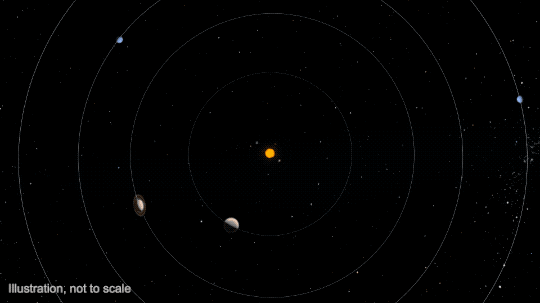
An asteroid belt circles the Sun between Mars and Jupiter. Beyond Neptune is a doughnut-shaped region of icy objects called the Kuiper Belt. This is where dwarf planets like Pluto and Makemake are found and is likely the source of short-period comets (like Haley’s comet), which orbit the Sun in less than 200 years.
Scientists think that even farther out lies the Oort Cloud, also a likely source of comets. This most distant region of our solar system is a giant spherical shell storing additional icy space debris the size of mountains, or larger! The outer edge of the Oort Cloud extends to about 1.5 light-years from the Sun — that’s the distance light travels in a year and a half (over 9 trillion miles).
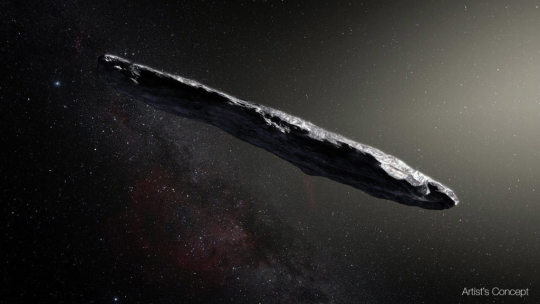
Sometimes asteroids or comets get ejected from these regions and end up sharing an orbit with planets like Jupiter or even crossing Earth’s orbit. There are even interstellar objects that have entered the inner solar system from even farther than the Oort Cloud, perhaps coming all the way from another star!
Our home galaxy
Let's zoom out to look at the whole Milky Way galaxy, which contains more than 100 billion stars. Many are found in the galaxy’s disk — the pancake-shaped part of a spiral galaxy where the spiral arms lie. The brightest and most massive stars are found in the spiral arms, close to their birth places. Dimmer, less massive stars can be found sprinkled throughout the disk. Also found throughout the spiral arms are dense clouds of gas and dust called nebulae. The Sun lies in a small spiral arm called the Orion Spur.
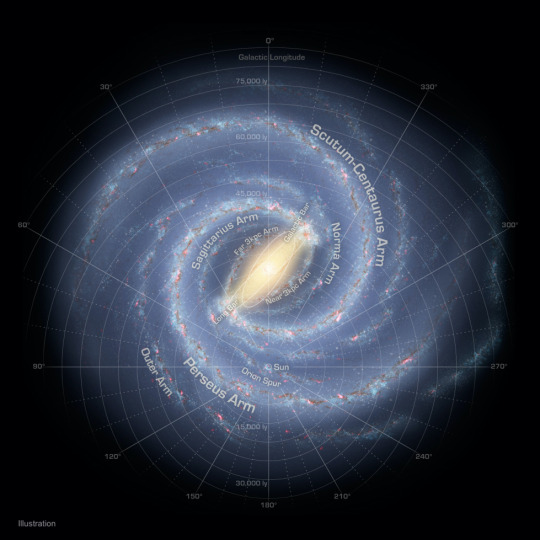
The Milky Way’s disk is embedded in a spherical “halo” about 120,000 light-years across. The halo is dotted with globular clusters of old stars and filled with dark matter. Dark matter doesn’t emit enough light for us to directly detect it, but we know it’s there because without its mass our galaxy doesn’t have enough gravity to hold together!
Our galaxy also has several orbiting companion galaxies ranging from about 25,000 to 1.4 million light-years away. The best known of these are the Large and Small Magellanic Clouds, which are visible to the unaided eye from Earth’s Southern Hemisphere.
Our galactic neighborhood

The Milky Way and Andromeda, our nearest neighboring spiral galaxy, are just two members of a small group of galaxies called the Local Group. They and the other members of the group, 50 to 80 smaller galaxies, spread across about 10 million light-years.
The Local Group lies at the outskirts of an even larger structure. It is just one of at least 100 groups and clusters of galaxies that make up the Virgo Supercluster. This cluster of clusters spans about 110 million light-years!

Galaxies aren’t the only thing found in a galaxy cluster, though. We also find hot gas, as shown above in the bright X-ray light (in pink) that surrounds the galaxies (in optical light) of cluster Abell 1413, which is a picturesque member of a different supercluster. Plus, there is dark matter throughout the cluster that is only detectable through its gravitational interactions with other objects.
The Cosmic Web
The Virgo Supercluster is just one of many, many other groups of galaxies. But the universe’s structure is more than just galaxies, clusters, and the stuff contained within them.
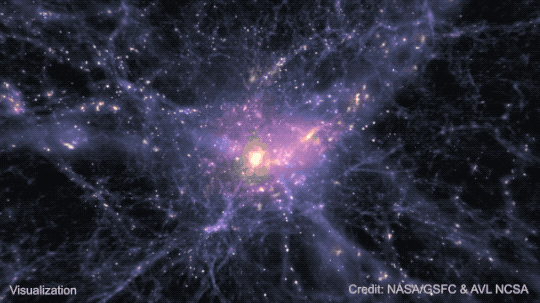
For more than two decades, astronomers have been mapping out the locations of galaxies, revealing a filamentary, web-like structure. This large-scale backbone of the cosmos consists of dark matter laced with gas. Galaxies and clusters form along this structure, and there are large voids in between.
The scientific visualizations of this “cosmic web” look a little like a spider web, but that would be one colossal spider! <shudder>

And there you have the different communities that define Earth’s place in the universe. Our tiny planet is a small speck on a crumb of that giant cosmic web!
Want to learn even more about the structures in the universe? Check out our Cosmic Distance Scale!
Make sure to follow us on Tumblr for your regular dose of space.
3K notes
·
View notes
Text
10 Myths About Psychology

Hello, Psych2goers! If you have followed Psych2go long enough, did the concept of psychology change before you encountered this channel? Which of the following point(s) did you use to believe in? If you’re new to Psych2go, welcome! Let’s get started with 10 misconceptions that most people assume.
1. We only use 10% of the brain
Perhaps you have heard this phrase a few times already, but we actually don’t only use just 10%. Our brain is constantly working and it always uses energy to keep us functioning. For example, our perceptions, emotions, movements and other behaviors rely heavily on several parts of the brain (Ilardi, 2019).
2. OCD means perfection and neatness
This is usually how movies and the media portray people with OCD. They put everything in a specific order and maintain cleanliness, but this behavior is considered OCPD rather than OCD. In fact, they tend to experience unwanted thoughts, repeated actions and rituals (Ilardi, 2019).
3. Medication fixes it
Continue Reading…
42 notes
·
View notes
Photo

Dementia Starts Sooner Than You Think
But it’s never too late (nor too soon) to take these preventive steps
Long before you routinely forget where you left the keys or why you walked into a room, the wheels of cognitive decline could be turning in your brain, setting you on a course to eventual dementia.
But dementia is not inevitable, experts say.
Several new and recent studies strengthen the case for prevention strategies that you can employ starting right now — no matter how old you are — to improve your chances of staying sharp down the road.
“The underlying process related to cognitive decline starts in early adult life, and probably even earlier,” Walter Willett, MD, a professor of epidemiology and nutrition at the Harvard T.H. Chan School of Public Health, said. “Thus I don’t think we can start too soon.”
Before you know it
For reasons still somewhat mysterious, brain cells sometimes stop working, and connections between brain centers weaken, leading to poorer memory and thinking ability at the root of most forms of dementia. (One particular type, vascular dementia, is brought on by a stroke or other event that restricts blood flow to the brain.)
Yet for other people, the seeds of dementia can sprout frighteningly early in life.
Signs of Alzheimer’s disease, the most common form of dementia, typically start to appear in a person’s mid-sixties, if they show up at all. More than 6.2 million Americans over 65 deal with Alzheimer’s as do more than 50 million people globally. But the gradual accumulation of damage in the brain is thought to begin 10 years or more before symptoms appear.
Early-onset Alzheimer’s, a less common type that seems to have a stronger genetic component, can begin to show up in a person’s thirties.
Regardless of when it starts, dementia’s early signs can be subtle and hard to distinguish from brain farts we all experience now and then: forgetting a name or an appointment or struggling to pull up just the right word we know is buried somewhere in the mind. As these symptoms increase, a person is likely to struggle with reason and judgment, all of which can lead to frustration and intense negative emotions.
The many potential causes of dementia
There is no cure for Alzheimer’s or other forms of dementia, and scientists are in the early stages of figuring out all the causes. Heredity is known to affect but not entirely determine dementia risk. By one estimate, albeit one that’s not fully supported by data, about a third of all dementia cases could be prevented by improving various health, lifestyle, and societal risk factors, including physical activity, diet, depression, education, and loneliness.
Last month, researchers published in the journal Stroke a list of so-called “modifiable risk factors” for dementia:
Depression
Hypertension
Physical inactivity
Diabetes
Obesity
Hyperlipidemia (high level of fats in the blood)
Poor diet
Smoking
Social isolation (loneliness)
Excessive alcohol use
Sleep disorders
Hearing loss
“Dementia is not inevitable,” said panel member Deborah Levine, MD, a primary care provider at the University of Michigan Health. “Evidence is growing that people can better maintain brain health and prevent dementia by following healthy behaviors and controlling vascular risk factors.”
To be clear, if you have a parent or sibling with dementia, your odds of getting it are around 70% higher than someone without that genetic risk. But even then, you can reduce those odds significantly by pursuing healthy lifestyle options like those mentioned above, according to preliminary research presented earlier this year at an American Heart Association meeting.
“When dementia runs in a family, both genetics and nongenetic factors, such as dietary patterns, physical activity, and smoking status, affect an individual’s overall risk,” said that study’s leader, Angelique Brellenthin, PhD, an assistant professor of kinesiology at Iowa State University.
Along with addressing the above risk factors, the latest research suggests three solid ways to help prevent or at least stall dementia.
Increase physical activity
Among the most important steps you can take to lower your risk of dementia is to up your level of physical activity — from wherever it is now to more of it. Moderate physical activity, such as a brisk daily walk, has been shown to promote good overall physical and mental health, improving sleep, lessening symptoms of depression, and promoting good cognitive functioning.
Ample research argues for starting ASAP no matter how old you are.
Poor health in middle age — measured by lack of physical activity, poor diet, and high blood pressure — more than doubles the risk of dementia later in life.
In one study, sedentary adults started a six-month exercise program, after which they took cognitive tests. Compared to a control group that stayed sedentary, the 40-year-olds in the exercising group tested as though they were 30 years old, and the 60-year-olds tested as though they were 40.
Other research finds that people who were in relatively poor health when they were 18 to 30 years old — with high blood pressure, blood sugar, and cholesterol — scored worse on cognitive tests in their forties and fifties, compared to people who were healthier as young adults. Exercise is known to improve all those markers of health.
Challenge your mind
Some studies have suggested that challenging yourself mentally can help maintain good memory and thinking skills, but experts say more research is needed on this front. So here you go:
New findings published July 14 by the journal Neurology involved 1,978 people who were 80 years old, on average, and did not have dementia at the start of the study. During a seven-year monitoring period, 457 of them developed symptoms of Alzheimer’s disease. But overall, staying mentally active — by such things as writing letters, doing puzzles, playing card games, or reading — was linked to a five-year delay in the onset of symptoms.
“It’s never too late to start doing the kinds of inexpensive, accessible activities we looked at in our study,” says the study’s lead author, Robert Wilson, PhD, a clinical neuropsychologist at Rush University Medical Center in Chicago.
Choose colorful food
You might’ve heard about flavonoids, widely touted as powerful antioxidants that could help keep the mind sharp. Cause-and-effect is always difficult to determine with nutrition research, particularly when it relies on self-reporting of consumption. So again, more research is needed. Okay, then:
New research, published July 28 in Neurology, finds people who eat at least half a serving per day of food high in flavonoids have a 20% lower risk of cognitive decline compared to those who consume few flavonoids. The high-flavonoid foods are a colorful bunch: apples, blackberries, blueberries, celery, cherries, grapefruit, oranges, pears, peppers, and strawberries. The strongest apparent protective effect came from yellow and orange fruits and vegetables, which contain high levels of a particular flavonoid called flavones.
“There is mounting evidence suggesting flavonoids are powerhouses when it comes to preventing your thinking skills from declining as you get older,” says Willett, the Harvard nutrition expert and a member of the study team. “Our results are exciting because they show that making simple changes to your diet could help prevent cognitive decline.”
The study, involving 77,335 middle-aged adults who were then monitored for 20 years, evaluated cognitive decline, not dementia, but other research shows cognitive decline is directly linked to the diagnosis of dementia, Willett notes.
While no single lifestyle change guarantees you won’t get dementia, the science has never more strongly suggested that you can exert some control over where your mind goes as you age.
“It’s never too late to start,” Willett says about improving your diet, “because we saw those protective relationships whether people were consuming the flavonoids in their diet 20 years ago or if they started incorporating them more recently.”
By Robert Roy Britt (Medium). Image by American Heart Association.
391 notes
·
View notes
Photo




On Having Whiteness
Donald Moss
Abstract
Whiteness is a condition one first acquires and then one has—a malignant, parasitic-like condition to which “white” people have a particular susceptibility. The condition is foundational, generating characteristic ways of being in one’s body, in one’s mind, and in one’s world. Parasitic Whiteness renders its hosts’ appetites voracious, insatiable, and perverse. These deformed appetites particularly target nonwhite peoples. Once established, these appetites are nearly impossible to eliminate. Effective treatment consists of a combination of psychic and social-historical interventions. Such interventions can reasonably aim only to reshape Whiteness’s infiltrated appetites—to reduce their intensity, redistribute their aims, and occasionally turn those aims toward the work of reparation. When remembered and represented, the ravages wreaked by the chronic condition can function either as warning (“never again”) or as temptation (“great again”). Memorialization alone, therefore, is no guarantee against regression. There is not yet a permanent cure.
Critical Theorists love to accuse science of being untrustworthy because, it’s claimed, the science is imbued with the cultural background values of the scientist who is doing it.
These same people then proceed to produce crap like this, which consists entirely of the biases of the author.
This accusation, then, appears to be a case of “accuse the other side of that which you are guilty.” It’s projection.
I would rather have a process that was vulnerable to a little bias that was also subject to correction by anyone who can put up a suitable case for correction, than a process that is filled entirely with bias which is unquestionable and not subject to any correction whatsoever. The last one is simply tyranny.
When untethered from the constraints of reality, when unfettered from the limitation of conforming conclusions to facts and available data and evidence (as in the case of non-fiction), or to the need to be commercially viable (as in the case of fiction), a polemic like this reveals far more about the mentality, astonishing racism and disdain for humanity of the author than it does anything about society.
This is now “knowledge,” by the way. Citable, “a paper says” knowledge.
So, Critical Race Theory seems to be going well…. When does all the human peace and unity kick in?
43 notes
·
View notes
Text
Did children build the ancient Egyptian city of Amarna? - Mary Shepperson

New evidence from Akhenaten’s capital suggests that a ‘disposable’ workforce of children and teenagers provided much of the labour for the city’s construction
Keep reading
142 notes
·
View notes






